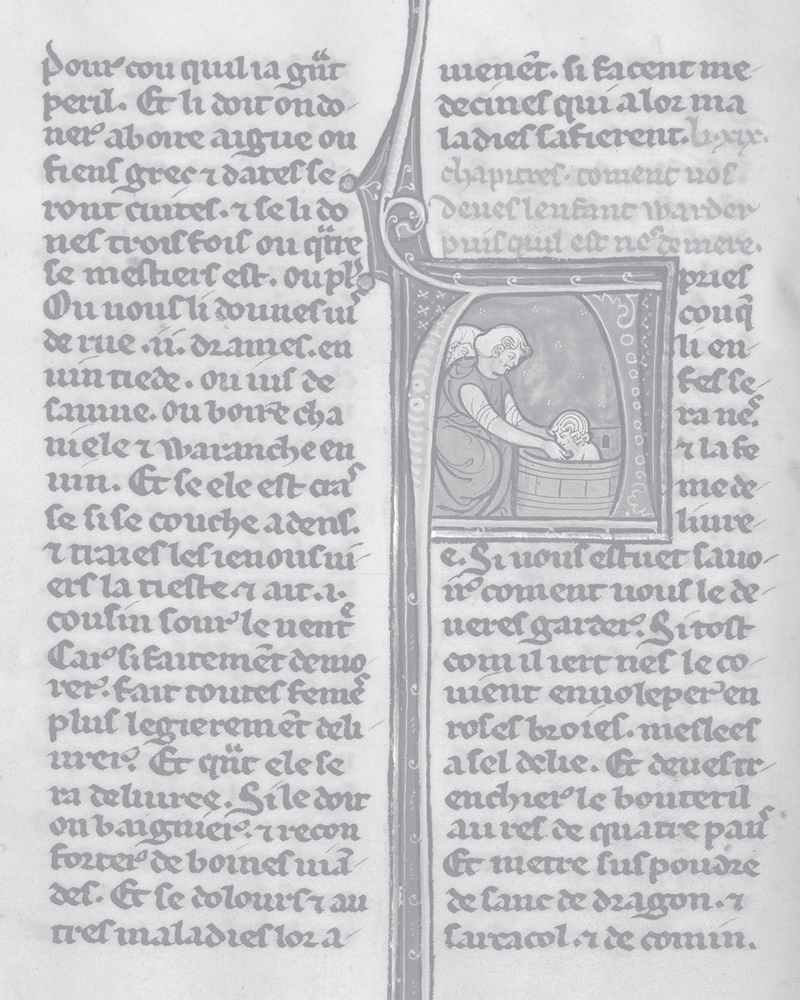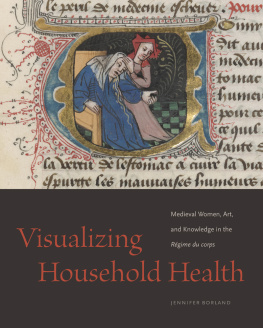Landmarks

Visualizing Household Health

Visualizing Household Health
Medieval Women, Art, and Knowledge in the Rgime du Corps
JENNIFER BORLAND
The Pennsylvania State University Press
University Park, Pennsylvania
Publication of this book has been supported by a Samuel H. Kress Foundation Grant from the International Center of Medieval Art.
Library of Congress Cataloging-in-Publication Data
Names: Borland, Jennifer Regan, author.
Title: Visualizing household health : medieval women, art, and knowledge in the Regime du corps / Jennifer Borland.
Description: University Park, Pennsylvania : The Pennsylvania State University Press, [2022] | Includes bibliographical references and index.
Summary: Examines several illustrated copies of the late medieval health guide known as the Regime du corps, demonstrating how the manuscripts depictions of household care highlight female-dominated expertise within the domestic sphereProvided by publisher.
Identifiers: LCCN 2021038343 | ISBN 9780271090597 (cloth)
Subjects: LCSH: Aldobrandino, da Siena, 1287. Regime du corpsIllustrations. | Medicine, MedievalEurope. | Medical careEuropeHistoryTo 1500. | WomenHealth and hygieneEuropeHistoryTo 1500. | Historiated initialsEuropeHistoryTo 1500.
Classification: LCC R141 .B66 2022 | DDC 610.94dc23
LC record available at https://lccn.loc.gov/2021038343
Copyright 2022 Jennifer Borland
All rights reserved
Printed in Korea
Published by The Pennsylvania State University Press,
University Park, PA 16802-1003
The Pennsylvania State University Press is a member of the Association of University Presses.
It is the policy of The Pennsylvania State University Press to use acid-free paper. Publications on uncoated stock satisfy the minimum requirements of American National Standard for Information SciencesPermanence of Paper for Printed Library Material, ANSI Z 39.481992.
Frontispiece: Newborn care. The Bute Painter, Le Rgime du corps, ca. 1285 ().
To Barbara Hagan and Suzanne Lewis,
incredible women who have provided endless encouragement and inspiration
and also to Dad, who I think would be proud
Contents
My appreciation must first go to those have been instrumental in helping me work on this book throughout its long development, reading and re-reading the text, facilitating momentum, cheering me with humor, and reminding me why we do this work. This book would simply not exist without Louise Siddons, a treasured colleague, collaborator, and friend for more than twenty years. Thank you for your generosity, collegiality, and devotion to this project. Sarah Kyles close reading, thoughtful feedback, and infinite kindness throughout the process have made this book so much better. Thanks as well to Rachael Cullick for her regular writing sessions, delivering consistent optimism and serenity over coffee and then over Zoom. Cassidy Petrazzi was instrumental in helping me manage the permissions and organization of my images, while also giving me much-needed encouragement in the final stages. I am so grateful to each of you for your constant support and enthusiasm.
Many wonderful scholars have contributed to this book by reading chapters or other sections, giving me feedback on other projects related to it, or providing general support and encouragement. My thanks to Tracy Chapman Hamilton, Jack Hartnell, Kathleen Kennedy, Amanda Luyster, Asa Mittman, Mariah Proctor-Tiffany, Benjamin Tilghman, and Theresa Tyers, who all provided excellent feedback along the way. The project was sustained by an invaluable network of colleagues and mentors, including Irene Backus, Lucy Bailey, Rebecca Brienen, Jennifer Brown, Shirin Fozi, Eliza Garrison, Emily Graham, Karen Greenwalt, Suzanne Lewis, Liz Roth, Alexa Sand, Sally Schuh, Karl Whittington, and Shaoqian Zhang. Angie Bennett, Holly Crocker, Mary Kate Hurley, Nicole C. Kirk, and Allie Terry-Fritschmembers of a fantastic online writing groupprovided inspiration and motivation at an especially critical moment. Much appreciation goes to the many scholars who provided feedback at conferences over the years, especially at the meetings of the Gender and Medieval Studies Group. I am grateful to Monica Green for introducing these manuscripts to me while I was still a graduate student; my book is unquestionably built on the foundation of her extensive body of scholarship. The feedback from external reviewers greatly improved this book, and I am grateful for their time and consideration. And I will never be able to say enough thanks for the wisdom, perspective, and laughter provided by my beloved Material Collective crew: Marian Bleeke, Rachel Dressler, Martha Easton, Anne Harris, Asa Mittman, Karen Overbey, Nancy Thompson, Benjamin Tilghman, and Maggie Williamsyou all rock.
Residential fellowships at the University of Pennsylvania and Rice University provided me with the time and resources to concentrate on researching and writing this book. As a Mellon Postdoctoral Fellow at the Penn Humanities Forum, I benefited greatly from the robust conversations and feedback I received, from both the other fellows in my cohortChiara Cillerai, Johanna T. Crane, Sindhumathi Revuluri, and Andrew Witmerand the many other scholars whom I met that year, especially Emily Hage, Jennie Hirsh, Timothy McCall, and Elly Truitt. Jennifer Conway and Sarah Varney also contributed to creating a remarkable environment for the fellows. Thank you as well to Holly Pittman and the rest of the Department of the History of Art for such generosity in welcoming back an alumna. Wonderful connections and conversations also took place at the Humanities Research Center at Rice University, and I am especially grateful to Melissa Bailar, Fars el-Dahdah, Linda Neagley, and Diane Wolfthal for fostering such collegiality during my year there.
The research and publication of this book have also been supported with grants from the International Center of Medieval Art, the Samuel H. Kress Foundation, Oklahoma Humanities, and the National Endowment for the Humanities. At Oklahoma State University, support came from the College of Arts and Sciences, the Vaughn Vennerberg Chair of Art fund, and the Department of Art, Graphic Design, and Art History. This project would not have come to fruition without the support of the Oklahoma State University Library, as well as the generosity of those at the British Library, the Bibliothque nationale de France, the Morgan Library and Museum, the Cambridge University Library, the Bodleian Library, the Rosenbach Library, and many others.
Thank you to the marvelous Eleanor Goodman for her encouragement, pragmatism, and infinite patience, and to the many other fantastic people at Pennsylvania State University Press for getting this book out into the world, including Maddie Caso, Laura Reed-Morrisson, and Regina Starace, as well as Nancy Evans of Wilsted and Taylor Publishing Services and Candace Hyatt.
I would like to acknowledge the previous publications upon which sections of this book are based. is based on the chapter Female Networks and the Circulation of a Late Medieval Illustrated Health Guide, in Moving Women, Moving Objects (4001500), edited by Tracy Chapman Hamilton and Mariah Proctor-Tiffany (Brill, 2019).
I am also incredibly grateful to family members who stayed upbeat about this project, cheered me on, and helped me finish it under unexpectedly challenging circumstances. I am especially grateful to my mother, Jane, who has over the years provided so much support, including countless hours spent reading to her grandchild over Skype to facilitate the final phase of this books completion. Thanks as well to Barbara, Kris, Bill, Jay, Rebecca, Robb, Heather, and Jess. I reserve special gratitude for my long friendship with Heather Olson, a fellow writer whose generosity and perspective enrich my life every day. I had just started the research for this project when my father, John, passed away, but I know he would be so happy about the end result.







